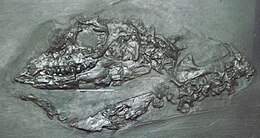| This article includes a list of general references, but it lacks sufficient corresponding inline citations. Please help to improve this article by introducing more precise citations. (October 2021) (Learn how and when to remove this message) |
| Paraplacodus Temporal range: Middle Triassic | |
|---|---|

| |
| Fossil skull | |
| Scientific classification | |
| Domain: | Eukaryota |
| Kingdom: | Animalia |
| Phylum: | Chordata |
| Class: | Reptilia |
| Superorder: | †Sauropterygia |
| Order: | †Placodontia |
| Genus: | †Paraplacodus Peyer, 1931 |
| Species | |
| |
Paraplacodus broilii is an extinct placodont sauropterygian from the Middle Triassic epoch, from the Anisian until Ladinian stages. The fossils were uncovered in Northern Italy and the species was named in 1931 by Bernhard Peyer. Paraplacodus means "Almost Placodus", in reference to its similarity to Placodus.


Like the majority of described placodonts, Paraplacodus was an aquatic reptile that fed on shellfish, though recent research suggests its diet was broader and not solely composed of hard-shelled organisms. Most known placodont species can be divided into two groups - the unarmored placodontoids, which would resemble a large, scaly, tooth-filled newt, or the armored cyamodontids, which would resemble a heavily armored turtle; Paraplacodus belonged to the former family. It was a small reptile, measuring about 1.5 metres (4.9 ft) in total body length.
The jaws of Paraplacodus were adapted to eat shellfish, with three pairs of protruding teeth in the top row and two rows of protruding teeth in the front of the jaw, with rounded crushing teeth in the upper and lower jaws. Thick ribs formed a box-like ribcage with an almost-square cross-section, which enabled Paraplacodus to remain close to the seabed while hunting for food.
References
- Gere, Kinga; Nagy, András Lajos; Scheyer, Torsten M.; Werneburg, Ingmar; Ősi, Attila (5 February 2024). "Complex dental wear analysis reveals dietary shift in Triassic placodonts (Sauropsida, Sauropterygia)". Swiss Journal of Palaeontology. 143 (1): 4. doi:10.1186/s13358-024-00304-x. ISSN 1664-2376. PMC 10844150. PMID 38328031.
- Rieppel, O. (2019). Mesozoic Sea Dragons: Triassic Marine Life from the Ancient Tropical Lagoon of Monte San Giorgio. Indiana University Press. p. 116. doi:10.2307/j.ctvd58t86. ISBN 978-0253040114. S2CID 241534158.
- Dixon, Dougal (2006). The Complete Book of Dinosaurs. Hermes House.
| Taxon identifiers | |
|---|---|
| Paraplacodus | |
This article about a Triassic reptile is a stub. You can help Misplaced Pages by expanding it. |






